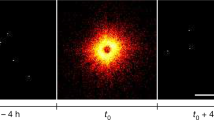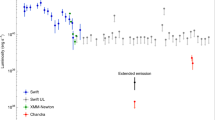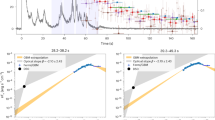Abstract
THE strong X-ray source in Scorpius has been identified with a very blue stellar object which has many of the characteristics of an old nova1,2. The object varies irregularly by up to half an astronomical magnitude from day to day, but the average brightness appears to have been essentially the same for the past 70 years2. Superimposed on these variations is a fast flicker with a time scale of the order of a minute or so. The X-ray spectrum is rather complex; if the X-rays are assumed to result from thin-source bremsstrahlung, then the 1–10 Å X-rays correspond to a temperature of about 5 × 107 °K (refs. 3–6), but the range from 44 to 60 Å contains additional radiation which must come from a region of lower temperature6. The visible radiation probably comes predominantly from the same thin-source bremsstrahlung, although hydrogen emission lines and helium, carbon, nitrogen, and oxygen absorption lines appear superposed on the continuum2. Three orders of magnitude more energy is emitted as X-radiation than as visible light.
This is a preview of subscription content, access via your institution
Access options
Subscribe to this journal
Receive 51 print issues and online access
$199.00 per year
only $3.90 per issue
Buy this article
- Purchase on Springer Link
- Instant access to full article PDF
Prices may be subject to local taxes which are calculated during checkout
Similar content being viewed by others
References
Gursky, H., Giacconi, R., Gorenstein, P., Waters, J. R., Oda, M., Bradt, H., Garmire, G., and Sreekantan, B. V., Astrophys. J. (in the press).
Sandage, A. R., Osmer, P., Giacconi, R., Gorenstein, P., Gursky, H., Waters, J., Bradt, H., Garmire, G., Sreekantan, B. V., Oda, M., Osawa, K., and Jugaku, J., Astrophys. J. (in the press).
Giacconi, R., Gursky, H., and Waters, J. R., Nature, 207, 572 (1965).
Chodil, G., Jopson, R. C., Mark, H., Seward, F. D., and Swift, C. D., Phys. Rev. Lett., 15, 605 (1965).
Grader, R. J., Hill, R. W., Seward, F. D., and Toor, A., Science, 152, 1499 (1966).
Friedman, H., Byram, E. T., and Chubb, T. A. (to be published).
Cameron, A. G. W., Nature, 205, 787 (1965).
Cameron, A. G. W., Nature, 206, 1342 (1965).
Osterbrock, D. E., Astrophys. J., 134, 347 (1961).
Whitaker, W. A., Astrophys. J., 137, 914 (1963).
Parker, E. N., Interplanetary Dynamical Processes (Interscience Publishers, New York, 1963).
Rosseland, S., The Pulsation Theory of Variable Stars (Clarendon Press, Oxford, 1949).
Schwarzschild, M., and Harm, R., Astrophys. J., 142, 855 (1965).
Colgate, S. A., and White, R. H., Astrophys. J., 143, 626 (1966).
Arnett, W. D., Canad. J. Phys. (in the press).
Author information
Authors and Affiliations
Rights and permissions
About this article
Cite this article
CAMERON, A. X-ray Emission from Old Novae. Nature 212, 493–494 (1966). https://doi.org/10.1038/212493a0
Issue Date:
DOI: https://doi.org/10.1038/212493a0
This article is cited by
-
Stellar Accretion and X-ray Emission
Nature (1967)
Comments
By submitting a comment you agree to abide by our Terms and Community Guidelines. If you find something abusive or that does not comply with our terms or guidelines please flag it as inappropriate.



